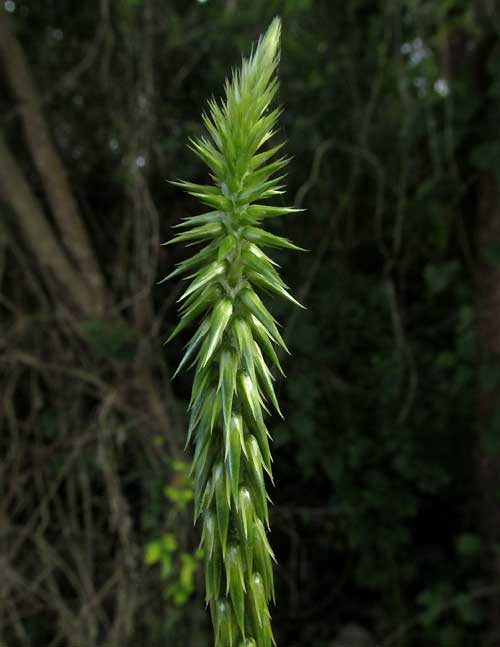Excerpts from Jim Conrad's
Naturalist Newsletter

from the December 27, 2015 Newsletter issued from Hacienda Chichen Resort beside Chichén Itzá Ruins, central Yucatán, MÉXICO
DEVIL'S HORSEWHIP
At the gravel road's edge near the vulture-friendly local landfill a population of knee-high herbs with strange-looking flowering heads contributed to the season's general profound greenness, as shown above.
It's one of those plants whose flowers arrange themselves in slender spikes, the spikes' tips bearing young, immature flowers and pointing upward, but immediately below them older flowers at the peak of their sexual effectiveness spread outward -- being more exposed to pollinators and/or wind -- while below these sexually active flowers the older-still flowers mature into fruits while nodding downward, becoming less noticeable to pollinators as they ripen. A close-up featuring the flowers' three stages of development is shown below:

Here it's seen that the outward-spreading flowers, the ones at the peak of their sexual activity, don't appear to be open. Open flowers on neighboring plants also couldn't be found, and I just don't know what's going on. Maybe they open only at a specific time of the day, or maybe in this strain they somehow get by closed. Pictures on the Internet show plants with open flowers.
Anyone familiar with common amaranths, celosias and the like will recognize that these landfill plants belong to the Amaranth Family, or Amaranthaceae. Amaranth Family flowers don't produce corollas, but rather make do with scale-like "tepals," which are neither petals nor sepals, but something in-between.
Before setting off to identify this interesting plant the leaves were photographed, shown below:

Our plants are ACHYRANTHES ASPERA, sometimes called Prickly Chaff-flowers but more picturesquely referred to as Devil's Horsewhip. Devil's Horsewhip, which seems to be a native tropical-American plant, thrives in disturbed sites throughout the world's tropics, and varies widely from place to place, six varieties being formally recognized. In many cultures it's regarded as exhibiting exceptional medicinal value, so it goes by many names in many languages.
Especially in India the plant is used both to induce abortion and labor, plus it helps stop postpartum bleeding. Also Indians use the crushed plant for pneumonia, and make an infusion of the root for bowel complaints. "Teas" of powdered leaves with honey or sugar candy are used in early stages of diarrhea and dysentery. For snake bites, the ground root is given with water until the patient vomits and regains consciousness. In Kenya the Maasai people use the plant to ease the symptoms of malaria. Though almost all the plant's parts are used for one medical problem or another, the most commonly employed parts are the seeds, roots and shoots.
There may be something to these traditional uses. A 2006 paper by Workineh Shibeshi and others in the journal African Health Sciences found that "The methanolic leaves extract of Achyranthes aspera possesses anti-fertility activity, which might be exploited to prevent unwanted pregnancy and control the ever-increasing population explosion."
To top it all off, Devil's Horsewhip's leaves can be eaten as a potherb, and its seeds are rich in protein, and edible when cooked.